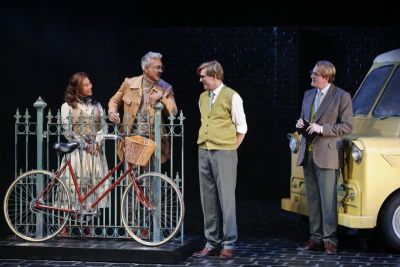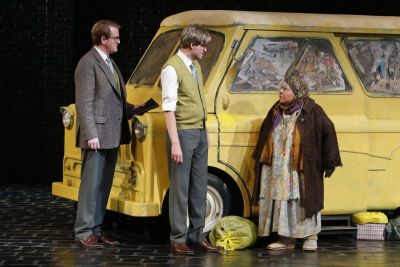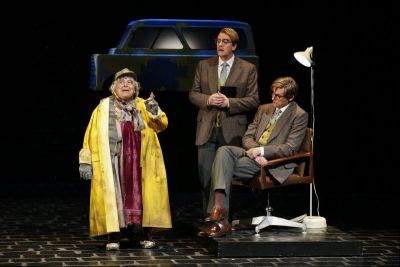The Lady in the Van
The longevity of this play (first performed in 1999) is more than likely due to the situation it dramatises. It depicts a kind of middle-class suburban nightmare: a homeless person, irrational, shit-smeared and endlessly importunate – plus bulky vehicle – camped in a nice, well-meaning person’s front garden and that person – that is, us – is somehow powerless to do anything about it.
But The Lady in the Van is also about Alan Bennett – and his ambivalence – as it is about Miss Shepherd, the lady in the van. As any Alan Bennett fan knows, The Lady in the Van is a ‘true story’. A 60-something woman calling herself ‘Mary Shepherd’ inveigled Mr Bennett into allowing her to park her Bedford van in his Camden Town driveway for, she said, three months. She and the van stayed fifteen years. A true story – but as told in the play, it is as ‘true’ as he tells it by way of selection, interpolation, conflation, exaggeration, invention to fill in some gaps and some shaping to give the story ‘dramatic form’ – which is what writers do – even if some feel guilty about it.
Mr Bennett puts himself as a character in his play. In fact, he is two characters, ‘A. Bennett 1’ (Daniel Frederiksen), the literal Alan Bennett, the public persona, the nice fellow who simply cannot get rid of – or cannot think of a valid reason to get rid of - the eyesore van and Miss Shepherd (Miriam Margolyes), its demanding, cantankerous, vile-smelling occupant. It’s not that he feels sorry for her, nor that allowing her to stay year after year is some act of saintly charity – it’s more ambiguous than that.

Note the title: The Lady – not the ‘woman’- in the Van. ‘Lady’ is so much more polite, nicer – and although ‘A. Bennett 1’ protests vehemently in the play, ‘I’m not nice!’ – his niceness is a crucial factor.
The less nice side of Alan Bennett – ‘A. Bennett 2’ (James Millar) – is the somewhat vampiric writer, fascinated by the situation, making notes of whatever peremptory or just crazy stuff Miss Shepherd says – as well as what Bennett 1 says, or the naïve, cliché Social Worker (Claire Healy), or the upwardly mobile couple across the road (Fiona Choi and Dalip Sondhi), or Bennett’s Mam (Jillian Murray) or, indeed, the character Bennett 2 may or may not have made up, ‘Underwood’ the blackmailer. Sometimes Bennett 1 and Bennett 2 bicker, such as when Bennett 1 is shocked at Bennett 2’s objective writer’s glee, or when Bennett 1 appears to explode in exasperation only to have Bennett 2 chide, ‘You never said that.’ And Bennett 1 replies, ‘No, but I’d have liked to…’
So, The Lady in the Van combines the social problem of the intractable, possibly mentally disturbed homeless, and the way a writer will prey upon a situation – even an impossible one – and turn it into art. It is the tension between these two elements that is the power of the play. But how well does this Melbourne Theatre Company production realise and deliver all that? Set and costume designer Alicia Clements – in collaboration with director Dean Bryant – makes what are – to me – some strange choices. Why is the upstage dominated by a high (and ominous) black brick wall, which parts to admit the van – but then allows anyone unimpeded access to the van? What is the significance of this black wall anyway? Or of the many period street lamps? Then there are the scale models of the van itself, another vehicle Miss Shepherd acquires and an ambulance, all of which run across the top of the wall. Cute, but why? Why do chairs and bits of fence trundle onto the stage and off again? This may be inventive, but it’s inapt and draws attention to the wrong places.

Mr Fredrickson does well as the ‘public’, ‘nice’, boyish Bennett 1, who must deal face-to-face with Miss Shepherd, combining that ‘niceness’ with increasing degrees of frustration and resentment. One might question, however, whether Mr Millar, as Bennett 2 – smooth, sophisticated, cynical and relentless - provides sufficient contrast to the public persona – or indeed whether the text allows him to.
Gillian Murray, on the other hand, in the role of Bennett’s mother, gets to air a more judgemental if matter-of-fact assessment of Miss Shepherd in her very few moments on stage. Richard Piper distinguishes very nicely among the four functional characters he plays – there to provide exposition. With the small cameo roles, Mr Bennett, the playwright, veers into the congenial territory of satire. Claire Healy is stuck with playing a social worker who is kind but, really, remarkably stupid. Fiona Choi and Dalip Sondhi get across the ‘rather you than us’ note of the neighbours, Pauline and Rufus, but these characters seem more designed to get laughs – and they certainly do! – than illuminate the situation – except to say that Bennett 1 is alone with his predicament – a predicament he chooses to have.

My greatest reservation, I regret to say, is with Ms Margolyes. Evidently the MTC intended this production as a vehicle for her, but her forte is loveable eccentrics, played with practiced and precise comic timing. (Her ‘Sairey Gamp’ in her Dickens’ Women show is unforgettable.) Comic timing is essential to this role – with its non sequiturs, its ‘knight’s move’ associations, her incredible claims and her blithe denial that she is creating any sort of problem – all that Ms Margolyes does extremely well – as she does the pathos of the sad, sad story of how she came to this. (True or Mr Bennett’s invention?) What’s lacking is that Ms Margolyes is not scary. Can a small (in this case small) old woman be scary? Yes. In the gimlet gaze, the brook no resistance tone, the reminder of the female authority figures of childhood. Cf. Maggie Smith’s Miss Shepherd in the movie version who, unlike Ms Margolyes, is scary because she exhibits that steely authority and command – even if the character has no right to either – by which she cows and positively intimidates ‘nice’ Bennett 1.
That said, Miss Shepherd is (was) a gift to Mr Bennett – that is, to ‘Bennett 2’ - but a gift that perhaps was too good to resist when a little resistance – that is, economy - would not have hurt. Is there perhaps more of her than we need?
Michael Brindley
Photographer: Jeff Busby
Subscribe to our E-Newsletter, buy our latest print edition or find a Performing Arts book at Book Nook.

